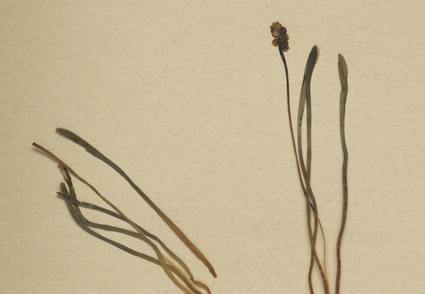Abstract
The genus Muscari Miller (1754: 926; Asparagaceae) comprises about 80 species (Böhnert et al. 2023) of mainly spring-flowering geophytes and, like many other genera in the Mediterranean, it has a long and turbulent taxonomic history (Garbari & Greuter 1970, Davis & Stuart 1980, Speta 1982). The most recent attempt to formalize the generic boundaries was made by using genome-wide single nucleotide polymorphism data resulting in a comprehensive generic treatment in its widest sense that accepts five subgenera, of which one is described as new (Böhnert et al. 2023). The genus in its current circumscription sensu Böhnert et al. (2023) is mainly distributed in the Mediterranean region, but reaches as far as temperate Europe in the west to Afghanistan in the east (Davis & Stuart 1980, Breckle & Rafiqpoor 2010), while Turkey and Greece must be regarded as centres of species diversity for the genus (Davis & Stuart 1984, Dimopoulos et al. 2013, Böhnert & Lobin 2017). Several species have attracted horticultural attention for centuries and subsequently many species have been described from cultivation, which led to a complex taxonomic situation, and several taxonomic names still remain without typification.
References
<p>Böhnert, T. & Lobin, W. (2017) <em>Leopoldia neumannii </em>sp. nov. (Asparagaceae, Scilloideae): a new species of <em>Muscari </em>sensu lato from Greece. <em>Willdenowia </em>47: 179–185. https://doi.org/10.3372/wi.47.47210</p>
<p>Böhnert, T., Neumann, M., Quandt, D. & Weigend, M. (2023) Phylogeny based generic reclassification of <em>Muscari</em> sensu lato (Asparagaceae) using plastid and genomic DNA. <em>Taxon</em>: 1–17. https://doi.org/10.1002/tax.12864</p>
<p>Boissier, E. (1859) <em>Diagnoses Plantarum Orientalium Novarum. 3,4</em>. Herrmann, Ramboz, Lipsiae, Geneve, 146 pp. Available from: https://www.digitale-sammlungen.de/en/view/bsb10301137?page=108,109 (accessed 31 October 2022)</p>
<p>Breckle, S.-W. & Rafiqpoor, M.D. (2010) <em>Field guide Afghanistan. Flora and vegetation</em>. Scientia Bonnensis, Bonn, 861 pp.</p>
<p>Catalogue des herbiers de Genève (CHG) (continuously updated) Conservatoire & Jardin botaniques de la Ville de Genève. Available from: http://www.ville-ge.ch/musinfo/bd/cjb/chg (accessed 18 January 2023)</p>
<p>Davis, P.H. & Stuart, D.C. (1980) <em>Muscari</em> Miller. <em>In: </em>Tutin, T.G., Heywood, V.H., Burges, N.A., Moore, D.M., Valentine, D.H., Walters, S.M. & Webb, D.A. (Eds.) <em>Flora Europaea Volume V. Alismataceae to Orchidaceae (Monocotyledones). </em>Cambridge Univ. Press, Cambridge, pp. 46–49.</p>
<p>Davis, P.H. & Stuart, D.C. (1984) <em>Muscari</em> Mill. <em>In: </em>Davis, P.H. (Ed.) <em>Flora of Turkey. </em>University Press, Edinburgh, pp. 245–263.</p>
<p>Dimopoulos, P., Raus, T., Bergmeier, E., Constantinidis, T., Iatrou, G., Kokkini, S., Strid, A. & Tzanoudakis, D. (2013) <em>Vascular plants of Greece. An annotated checklist</em>. Botanic Garden and Botanical Museum, Berlin-Dahlem, 372 pp.</p>
<p>Garbari, F. & Greuter, W. (1970) On the taxonomy and typification of <em>Muscari </em>Miller (Liliaceae) and allied genera, and on the typification of generic names. <em>Taxon </em>19: 329–335. https://doi.org/10.2307/1219056</p>
<p>Jordan, A. & Fourreau, J.P. (1870) <em>Icones ad Floram Europae</em>. F. Savy, Paris, 52 pp. Available from: https://gallica.bnf.fr/ark:/12148/bpt6k96713046/f3.item (accessed 31 October 2022)</p>
<p>Linnaeus, C. (1753) <em>Species plantarum</em>. Salvius, Stockholm, 1200 pp. Available from: https://doi.org/10.5962/bhl.title.37656 (Accessed 13 January 2023)</p>
<p>Miller, P. (1754) <em>The gardeners dictionary. Abridged</em>, 4th ed. London, 468 pp. Available from: https://www.biodiversitylibrary.org/item/150894#page/406/mode/1up (accessed 13 January 2023)</p>
<p>Miller, P. (1768) <em>The gardeners dictionary</em>. <em>Abridged</em>, 8th ed. London, 1367 pp. Available from: https://www.biodiversitylibrary.org/page/394481#page/775/mode/1u (accessed 31 October 2022)</p>
<p>Speta, F. (1982) Über die Abgrenzung und Gliederung der Gattung <em>Muscari</em>, und über ihre Beziehungen zu anderen Vertretern der Hyacinthaceae. <em>Botanische Jahrbücher für Systematik, Pflanzengeschichte und Pflanzengeographie </em>103: 247–291.</p>


